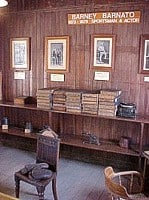The Big Hole official site informs you about the Old Town brings the New Rush era to life, where the hopeful, the desperate and the determined flocked to the town of Kimberley to seek their fortunes.
You’ll discover period buildings that have been preserved or restored to their original glory; these include a church built in Europe and shipped to Kimberley, Barney Barnato’s boxing academy, the digger’s sleeping quarters and the De Beers railway coach, used by Cecil John Rhodes to commute between Cape Town and Kimberley.
The Old Town gives you the unique opportunity to see how Kimberley would have looked in its heyday. Open seven days a week from 08:00 in the morning until 17:00 in the afternoon, gives guests the opportunity to browse around in the old buildings for free.

Kimberley’s
Oldest House
This wooden prefabricated home, imported from England in 1877, was considered luxurious by those living in tents and shacks.

Diamond Buyer’s Office
A rather more substantial shelter than most buyers enjoyed, it contains relics of famous dealers and magnates, for example, a desk of Alfred Beit, a life governor of De Beers and one of the original directors of the company.

The German Lutheran
Church of St Martini
As early as 1845 a Lutheran mission was established at Pniel and when Kimberley came into being the Rev. Carl Meyer, resident minister at Pniel, became the first Lutheran minister. Services were held first at the High Court of Griqualand West, but in 1875 the Church of St. Martini was erected in Thompson Street. The last service was held in the church on 3 February 1963, by which time a new church had been built in Lawson Street. The old church, with all its original fittings and awe inspiring atmosphere was then transferred to The Big Hole in 1964. A display of the workbench and tools used in the construction of the church by August Müller may be seen at the back of the church. The recorded music that is playing in the church was played in the St John’s Evangelical Lutheran Church, King Williams town by the organist Miss Vicky Egalov. Read more facts about the Big Hole in Kimberley.
All material used in the construction of this church had to come from overseas via Port Elizabeth and then by oxwagon to Kimberley.

Diggers Rest
A replica of one of the 128 pubs which flourished in Kimberley in the early days. This captivating “pub” with its life-like baren, atmospheric music, apt furnishings and flat roof with a sloping verandah canopy was in its day an extremely popular haunt of both buyers and sellers.

Barney Barnato’s Boxing Academy
In this original building Barney Barnato first earned a living. With shrewdness, hard work and good fortune, he gained control of the Kimberley Central Mining Company which dominated the Kimberley Mine. His long struggle with Cecil Rhodes for control ended when Rhodes’ Company paid £5 338 650 to the Kimberley Central Company and De Beers Consolidated Mines was established. Barnato was made life governor of De Beers and a member of the Kimberley Club.
Barney, whose real name was Barnato Isaac had learned the art of boxing in Whitechapel, London.. His boxing academy was established in 1878 in Pniel Road. This building was moved to the Big Hole in 1956.

Sir David Harris’ Ballroom
This gracious building was erected in 1901 in the garden of Colonel Sir David Harris’ home – Lancaster Lodge, 136 Du Toits Pan Road. It was moved to the Big Hole in 1966.Colonel Sir David Harris was a director of De Beers from 1897 to 1931.
Mine Managers House
A replica of the house occupied by succedding managers of the Kimberley Mine. The ornate Victorian furnishings contrast strongly with the simplicity of the other houses. The original house stood on a pile of blue ground overlooking the mine in North Circular Road and known as “the Hill”. You should definitely visit the Kimberley Mine Museum.







